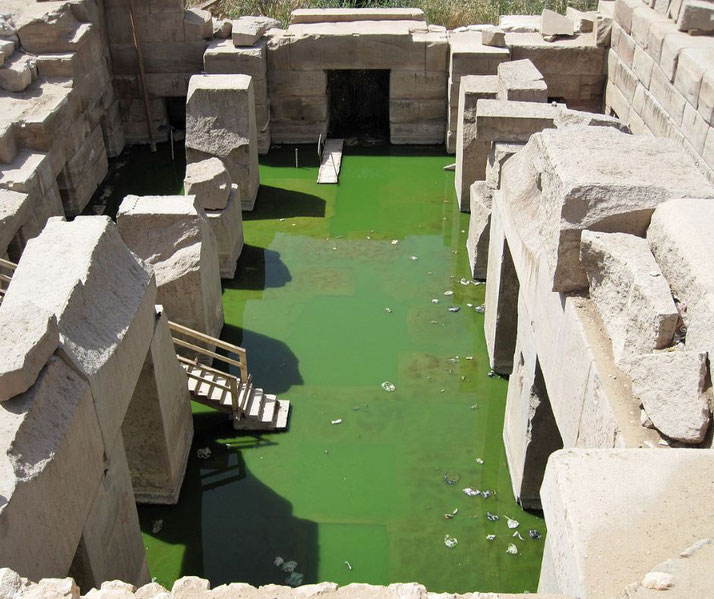The unexplained Osireion: Ancient Egypt's most mysterious structure

Hidden away in the sands next to the ancient city of Abydos, the Osireion remains one of Egypt's most enigmatic structures.
Often overshadowed by the grandeur of the pyramids and the Sphinx, this subterranean complex has puzzled archaeologists and historians for over a century.
Its unique layout, featuring massive granite blocks and a design that seems almost anachronistic, raises questions about the Osireion's true origins and purpose.
The strange location and history of the Osireion
The Osireion is situated in Abydos, one of ancient Egypt's most significant religious centers.
Abydos was a place of pilgrimage and worship, dedicated primarily to Osiris, the god of the afterlife.
The Osireion itself is often attributed to Pharaoh Seti I of the 19th Dynasty, who ruled during the New Kingdom period, a time of unprecedented prosperity and architectural grandeur in ancient Egypt.
However, the dating of the Osireion has been a subject of much debate among scholars.
Some argue that its architectural style and the materials used suggest a much older origin, possibly even predating the dynastic era.
The mysterious nature of its design
Unlike the ornate temples and pyramids that define much of ancient Egyptian architecture, the Osireion presents a stark contrast with its austere and monolithic design.
The structure is predominantly subterranean, carved into the bedrock and partially covered by the sands of time.
It features a central hall surrounded by a moat-like channel, which some believe was designed to be filled with water, symbolizing the primeval waters of creation in Egyptian mythology.
The central hall is flanked by two rows of massive pillars, each hewn from a single piece of red granite, a material that would have had to be transported from quarries hundreds of miles away.
These pillars support enormous lintel blocks, adding to the awe-inspiring scale of the construction.
One of the most perplexing aspects of the Osireion's architecture is its use of megalithic stones, some weighing upwards of a hundred tons.
The sheer size and weight of these stones have led many to question how such an architectural feat could have been accomplished with the tools and methods believed to be available during the New Kingdom period.
Moreover, the structure's layout and design elements, such as the absence of inscriptions and the use of straight lines and right angles, are atypical for Egyptian temples of the time.
Another intriguing feature is the Osireion's alignment. The structure is oriented to the true north, a level of precision that suggests advanced knowledge of astronomy and mathematics.
This has led to speculation about the Osireion serving not just a religious or funerary purpose, but perhaps also an astronomical or calendrical one.
The absence of decorative elements commonly found in other Egyptian temples—such as hieroglyphic inscriptions, frescoes, or statuary—adds to its enigmatic nature.
It's as if the Osireion was designed to be functional rather than ornamental, yet its exact function remains elusive.

What was the Osireion really built for?
Traditional Egyptological perspectives often link the Osireion to Pharaoh Seti I, suggesting that it served as a sort of cenotaph or symbolic tomb.
This theory is bolstered by the structure's proximity to the Temple of Seti I and its alignment with the cult of Osiris, the god of the afterlife.
However, this explanation is not without its challenges. The absence of inscriptions, the unique architectural features, and the use of megalithic stones all raise questions about whether the Osireion could have been constructed during Seti I's reign.
Alternative theories have emerged to fill the gaps left by traditional explanations.
Some propose that the Osireion is far older than commonly believed, possibly predating the dynastic era of ancient Egypt.
Proponents of this view point to the megalithic construction techniques and the structure's astronomical alignment as evidence.
Others have even ventured into the realms of the speculative, suggesting extraterrestrial involvement or attributing the Osireion to the mythical lost continent of Atlantis.
While these theories are dismissed by mainstream scholars, they continue to capture the public imagination and contribute to the ongoing debate.
The religious and mythological significance of the Osireion adds another layer of complexity to theories about its origin and purpose.
The structure's design, featuring a central hall surrounded by a water channel, has been interpreted as a symbolic representation of the "Island of Flame," a mythical place associated with the Osiris legend.
This has led some to speculate that the Osireion served a ritualistic purpose, possibly as a site for initiation ceremonies or as a representation of the afterlife.
In recent years, interdisciplinary approaches have sought to reconcile various theories by considering the Osireion's role in the broader cultural and historical context of ancient Egypt.
Some researchers are exploring the possibility that the structure served multiple purposes over time, adapting to the changing religious and political landscape.
What do you need help with?
Download ready-to-use digital learning resources
Copyright © History Skills 2014-2025.
Contact via email
With the exception of links to external sites, some historical sources and extracts from specific publications, all content on this website is copyrighted by History Skills. This content may not be copied, republished or redistributed without written permission from the website creator. Please use the Contact page to obtain relevant permission.





